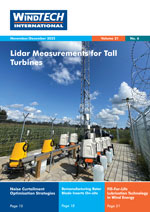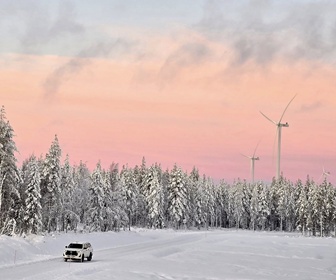- Category: Product News
GE Energy has introduced the WindBOOST control system upgrade, designed to increase the output of its 1.5sle wind turbine.
- Category: Product News
GE Energy has announced that its 2.5MW wind turbine is coming to America. The 2.5xl will be launched in North America in 2010.
- Category: Product News
3TIER has announced the launch of an application programming interface called FirstLook API.?This new service provides the technical mechanism and licensing rights for third parties to integrate 3TIER’s wind and solar resource datasets into their own operations and customer experiences.
- Category: Product News
Azima DLI has announced WATCHMAN Remote Monitoring Services for the wind power industry. WATCHMAN Remote is a subscription-based service that addresses the equipment reliability and uptime needs of wind park owners by supporting safe and cost effective machine condition monitoring of remote or unmanned installations.
- Category: Product News
3TIER has announced it has expanded the geographical coverage of its FirstLook Assessment Reports, which provide detailed estimates of wind resources for potential wind energy development locations, to include Western and Eastern Europe, much of Asia, and the Pacific Rim.
- Category: Product News
Alpha Wire? introduced a new product offering for the wind power market. The company has created a portfolio of high-performance cable for applications in the wind power market, including power distribution, control, and monitoring within the wind turbine.
- Avanti fixtures and safety equipment tested
- Field balancing of rotor blades
- New service for wind power plants from Pruftechnik
- Siemens introduces medium-voltage switchgear
- 6M is the world's most powerful wind energy turbine
- Ampair reveals new 6kW wind turbine
- NRG Systems expands product offerings
- Leviathan Energy completes testing of Wind Energizer
- China produces first 3MW wind turbine
- First three REpower 6M turbines fully erected
- 3TIER introduces next-generation wind assessment
- GE Energy unveils WindINERTIA
- GE Energy launches new service optimizing wind turbine layout
- Siemens introduces wind turbine for low to medium wind speeds
- PowerWind presents a 2.5MW wind energy converter
- First wind turbine with an ATS hybrid tower has been completed
- Tough erosion protection tapes for wind power stations
- Sage Oil Vac introduces gear oil exchange system for wind turbines
- Morphic's small-scale wind turbine in live tests
- WSI Launches WSI WindCast
- AMSC and US DOE to collaborate on 10MW wind turbines
- FirstLook Prospecting tool covers the world
- BGB engineering manufactures new contactless slip ring
- Climatronics introduces barometer for wind power density calculation
- New blade root repair method for restoring aging turbines
- First REpower 6M turbines assembled in Bremerhaven
- SCS announces a new fire and blast protection system
- More wind characteristics data now available on windNavigator
- 3TIER releases 5 kilometre wind map of the world
- REpower Systems AG installs prototype of the REpower 3.XM










